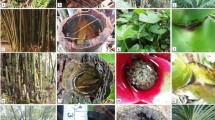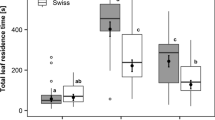Abstract
In this study we assessed microhabitat and host plant preferences of Aporia crataegi (Linne 1758) larvae in the field. The study was conducted in the submediterranean part of Slovenia, at the edge of the limestone region Kraški rob, where this species is widespread. The larvae were most abundant on blackthorn (Prunus spinosa L.) and the common hawthorn (Crataegus monogyna Jacq.), and infrequent on the rosehip (Rosa sp.) and rock cherry (Prunus mahaleb L.). Smaller shrubs with greater exposure to sun appeared to be preferred and larvae constructed their nests on outer branches of plants. The thermophilic nature of larvae was evident by the low and sheltered position of the nests, although in P. spinosa, which is more thermophilic than C. monogyna, they were positioned somewhat higher. As the nests and larvae occur mostly on plants growing in warmer microhabitats, larvae that had overwintered can take advantage of the quicker development of buds and leaves in early spring. The rocky ground below and around the occupied plants was often covered with grass, suggesting the need for cooler and warmer microclimate during hot summers and cold winters with strong winds, respectively. Densities of larvae and nests were positively but non-significantly correlated to density of host plants; however, in later successional stages, where host plants are most abundant, open and sunny microhabitats that can provide opportunities for larvae to warm up are lacking. The revival of the traditional management practices with extensive grazing with late and only occasional mowing may slow down the overgrowing process, leaving spiny host plants abundant and in close proximity to the nectaring sources for the adults.




Similar content being viewed by others
References
Akaike H (1973) Information theory and an extension of the maximum likelihood principle. In: Petrov BN, Csaki F (eds) Second International Symposium on Information theory. Akademiai Kiado, Budapest, pp 267–281
Albanese G, Vickery PD, Sievert PR (2008) Microhabitat use by larvae and females of a rare barrens butterfly, frosted elfin (Callophrys irus). J Insect Conserv 12:603–615
Asher J, Warren M, Fox R, Harding P, Jeffcoate G, Jeffcoate S (2001) The millennium atlas of butterflies in Britain and Ireland. Oxford University press, Oxford
Baguette M, Petit S, Quéva F (2000) Population spatial structure and migration of three butterfly species within the same habitat network: consequences for conservation. J Appl Ecol 37:100–108
Baylis M, Pierce NE (1991) The effect of host-plant quality on the survival of larvae and oviposition by adults of an ant-tended lycaenid butterfly, Jalmenus evagoras. Ecol Entomol 16: 1–9
Brauner N, Shacham M (1998) Role of range and precision of the independent variable in regression of data. AlChE J 44:603–611
Britten HB, Riley L (1994) Nectar source diversity as an indicator of habitat suitability for the endangered Uncompahgre fritillary, Boloria acrocnema (Nymphalidae). J Lep Soc 48:173–179
Burnham KP, Anderson, DR (2002) Model selection and multimodel inference: a practical information-theoretic approach, 2nd Edition. Springer, New York, 488
Čelik T (2007) Dnevni metulji (Lep.: Papilionoidea in Hesperioidea) kot bioindikatorji za ekološko in naravovarstveno vrednotenje Planinskega Polja. Varstvo narave 20:83–105
Čelik T (2013) Oviposition preferences of a threatened butterfly Leptidea morsei (Lepidoptera: Pieridae) at the western border of its range. J Insect Conserv 17:865–876
Črne M, Lužnik M, Jugovic J (2013) The impact of grazing on the occurence of Black-veined White, Aporia crataegi (Lepidoptera: Pieridae): International workshop on conservation biology, Koper, Slovenia, 14th May 2013
Dennis RLH (1984) Egg-laying sites in the Common blue butterfly, Polyommatus icarus (Rottemburg) (Lepidoptera: Lycaenidae): the edge effect and beyond the edge. Entomol Gaz 35: 85–93
Dennis RLH, Shreeve TG (1996) Butterflies on British and Irish offshore islands: ecology and biogeography. Geoffrey Morton, Printing Designer and Consultant. 131
Dennis RLH, Shreeve TG, Van Dyck H (2003) Towards a functional resource-based concept for a habitat: a butterfly biology viewpoint. Oikos 102(2):417–426
Dobkin DS, Olivieri I, Erlich PR (1987) Rainfall and the interaction of microclimate with larval resources in the population dynamics of ceheekerspot butterflies (Euphydryas edita) inhabiting serpentine grassland. Oecologia 71:161–166
Dzhangaliev AD, Salova TN, Turekhanova PM (2003) The Wild Fruit and Nut Plants of Kazakhstan. Horticult Rev 29:305–371
Eichel S, Fartmann T (2008) Management of calcareous grasslands for Nickerl’s fritillary (Melitaea aurelia) has to consider habitat requirements of the immature stages, isolation, and patch area. J Insect Conserv 12:677–688
Emmet AM, Heath J (1989) The moths and butterflies of Great Britain and Ireland, vol 7, part 1. Harley Books, Colchester
Fartmann T, Hermann G (2006) Larvaökologie von tagfaltern und Widderchen in Mitteleuropa—von den Anfängen bis heute. In: Fartmann T., Hermann G. (eds) Larvaökologie von Tagfaltern und Widderchen in Mitteleuropa. Abh Westf Mus Naturk 68 (3/4):11–57
Fielding AH, Bell JP (1997) A review of methods for the assessment of prediction errors in conservation presence/absence models. Environ conserv 24:38–49
Fischer K, Beinlich B, Plachter H (1999) Population structure, mobility and habitat preferences of the violet copper Lycaena helle (Lepidoptera: Lycaenidae) in Western Germany: implications for conservation. J Insect Cons 3:43–52
Fokin AV, Korovin AA (2001) Effect of biopreparations on trophic activity of caterpillars of lackey moth and pierid butterfly. Zashchita i Karantin Rasteniĭ 5:20
Garcia-Barros E, Fartmann T (2009) Butterfly oviposition: sites, behaviour and modes. In: Settele J, Shreeve T, Konvicka M, van Dyck H (eds) Ecology of butterflies in Europe. Cambridge University press, Cambridge, p 513
Grichanov IY, Ovsyannikova EI, Saulich MI (2004) Interactive agricultural ecological atlas of Russia and neighbouring countries. Economic plants and their diseases, pests and weeds. http://www.agroatlas.ru/en/content/pests/Aporia_crataegi/map/. Accessed 1 March 2017
Hermann G (2007) Tagfalter suchen im Winter – Zipfelfalter, Schillerfalter und Eisvögel. Books on demand GmbH, Norderstedt, 224
Jugovic J, Črne M, Fišer Pečnikar Ž (2013) The impact of grazing, overgrowth and mowing on spring butterfly (Lepidoptera: Rhopalocera) assemblages on dry karst meadows and pastures. Nat Croat 22 (1):157–169
Jugovic J, Črne M, Lužnik M (2017) Movement, demography and behaviour of a highly mobile species: a case study of Aporia crataegi (Lepidoptera: Pieridae). Eur J Entomol 114:113–122
Konvicka M, Hula V, Fric Z (2003) Habitat of the prehibernating larvae of the endangered butterfly Euphydryas aurinia (Lepidoptera: Nymphalidae): what can be learned from vegetation composition and architecture. Eur J Entomol 100:313–322
Koschuh A, Gepp J (2004) Zur Verbreitung und Ökologie dem Baum-Weisslings Aporia crataegi (L., 1758) in der Steiermark (Lepidoptera, Pieridae). Joannea Zool 6:175–186
Krauss J, Steffan-Dewenter I, Müller CB, Tscharntke T (2005) Relative importance of resource quality, isolation and habitat quality for landscape distribution of monophagous butterfly. Ecography 28:465–474
Kuussaari M, Heliölä J, Pöyry J, Saarinen K (2007) Contrasting trends of butterfly species preferring semi-natural grasslands, field margins and forest edges in northern Europe. J Insect Conserv 11:351–366
Löffler F, Stuhldreher G, Fartmann T (2013) How much care does a shrub-feeding hairstreak butterfly, Satyrium spini (Lepidoptera: Lycaenidae), need in calacreous grasslands? Eur J Entomol 110 (1):145–152
Matter SF, Roland J, Keyghobadi N, Sabourin K (2003) The effects of isolation, habitat area, and resources on the abundance, density and movements of the butterfly Parnassius smintheus. Ecol Entomol 27:308–316
McCullagh P, Nelder JA (1983) Generalized linear models. Chapman & Hall, London, p 261
Merrill RM, Gutiérrez D, Lewis OT, Gutiérrez J, Díez SB, Wilson RJ (2008) Combined effects of climate and biotic interactions on the elevational range of a phytophagous insect. J Anim Ecol 77:145–155
Mueller T, Fagan WF (2008) Search and navigation in dynamic environments – from individual behaviours to population distributions. Oikos 117:654–664
Nagelkerke NJD (1991) A note on a general definition of the coefficient of determination. Biometrika 78:691–692
Ogrin D (2007) Severe storms and their effects in sub-meditteranean Slovenia from the 14th to the mid-19th century. Acta Geog Slov 47 (1):7–24
Ohsaki N, Sato Y (1994) Foodplant choice of Pieris butterflies as a trade-off between parasitoid avoidance and quality of plants. Ecology 75:59–68
Porter K (1992) Eggs and egg-laying. In: Dennis RLH (ed) The ecology of Butterflies in Britain. Oxford University Press, Oxford, pp 46–72
QGIS User Guide, Release 2.0. QGIS Project. November 29, 2013. 281 pp. http://docs.qgis.org/2.0/pdf/QGIS-testing-UserGuide-pt_PT.pdf. Accessed on 15th December 2013
Quinn RM, Gaston KJ, Roy DB (1998) Coincidence in the distributions of butterflies and their foodplants. Ecography 21:279–828
R Core Team (2016) R: A language and environment for statistical computing. R Foundation for Statistical Computing, Vienna, Austria. https://www.R-project.org/
Rausher MD (1981) Host plant selection by Battus philenor butterflies: the role of predation, nutrition and plant chemistry. Ecol Monogr 51:1–20
Ruszkowski A (1960) Niestrzep glogowiec (Aporia crataegi L.). Prace Naukowe Instytutu Ochrony Roslin 2 (1):87–142
Sadigov GI (1992) The black-veined white butterfly. Zashchita Rasteniĭ (Moskva) 9:35
Searcy CA, Gabbai-Saldate E, Bradley Shaffer H (2013) Microhabitat use and migration distance of an endangered grassland amphibian. Biol Conserv 158:80–87
Singer MC (1972) Complex components of habitat suitability within a butterfly colony. Science 176:75–77
Smallidge PJ, Leopold DJ, Allen CM (1996) Community characteristics and vegetation management of Karner Blue Butterfly (Lycaeides melissa samuelis) on rights-of-way in east-central New York, USA. J Appl Ecol 33:1405–1419
SPSS Inc (1989, 2011) IBM SPSS Statistics 20 Core System. User’s Guide, 446
Stergaršek J (2009) Flora okolice kraja Dutovlje (kvadrant 0248/2). Diplomsko delo, Univerza v Ljubljani, Biotehniška fakulteta, Oddelek za biologijo, Ljubljana
Stoutjedijk P, Barkmann JJ (1992) Microclimate, vegetation and fauna. Oppulus Press, Uppsala, p 216
Stuhldreher G, Villar L., Fartmann T (2012) Inhabiting warm microhabitats and risk-spreading as strategies for survival of a phytophagous insect living in common pastures in the Pyrenees. Eur J Entomol 109: 527–534
Thomas JA (1984) The behaviour and habitat requirements of Maculinea nausithous (the dusky large blue butterfly) and M. teleius (the scarce large blue) in France. Biol Conserv 28:325–347
Thomas JA, Telfer MG, Roy DB, Preston CD, Greenwood JJD, Asher J, Fox R, Clarke RT, Lawton JH (2004) Comparative losses of British butterflies, birds, and plants and the Global Extinction Crisis. Science 303:1879–1881
Tkachev VM (1986) Protection of apple. Zashchita Rasteniĭ 5:24–25
Tolman T, Lewington R (2008) Collins butterfly guide. Harper Collins Publishers Ltd., London, p 384
Van Sway C, Warren M, Lois G (2006) Biotope use and trends of European butterflies. J Insect Conserv 10:189–209
Verovnik R, Rebeušek F, Jež M (2012) Atlas dnevnih metuljev (Lepidoptera: Rhopalocera) Slovenije. Atlas of Butterflies (Lepidoptera: Rhopalocera) of Slovenia. Center za kartografijo favne in flore, Miklavž na Dravskem polju, pp. 456
Watt WB, Boggs CL (2003) Synthesis: butterflies as model systems in ecology and evolution—present and future. In: Boggs CL, Watt WB, Ehrlich PR (eds) Butterflies−Ecology and evolution taking flight. University of Chichago Press, Chichago, pp 603–613
Weddell BJ (2002) Conserving living natural resources. In the Context of a Changing World. Cambridge University Press, Cambridge
Wilbert EL (1960) Apanteles pieridis (Bouché) (Hym., Braconidae), ein Parasit von Aporia crataegi (L.) (Lep., Pieridae). Entomophaga 5(3):183–211
Williamson E, Länger R (1999) Microscopy. In: Petrone C (ed) Hawthorn Leaf with Flower. Crataegus spp. Analytica, Quality Control, and Therapeutic Monograph. American Herbal Pharmacopeia and Therapeutic Compendium, p 5
Zangerl AR, Berenbaum MR (1992) Oviposition patterns and host plant suitability: parsnip webworms and wild parsnip. Am Midl Nat 128:292–298
Acknowledgements
We thank Teja Zakotnik, Mitja Črne, Ivan Jugovic, Sanda Jugovic and Sara Zupan for help in the field. Peter Glasnović and Tjaša Zagoršek provided useful help with GIS. Peter Glasnović provided useful information on presence of Crataegus spp. in the investigated area. Živa Fišer Pečnikar improved the manuscript with useful comments. We also thank Valerija Zakšek and Tatjana Čelik for providing literature and useful discussions. The study was financed through the framework of the postdoctoral project of the lead author at the University of Primorska [Microhabitat preferences of Black-veined White Aporia crataegi (Lepidoptera: Pieridae) on Karst Edge: UP-1142-59/2012], and represents the continuation of activities from CBC Programme Italy-Slovenia 2007–2013 (project BioDiNet—Network for the protection of biodiversity and landscape).
Author information
Authors and Affiliations
Corresponding author
Rights and permissions
About this article
Cite this article
Jugovic, J., Grando, M. & Genov, T. Microhabitat selection of Aporia crataegi (Lepidoptera: Pieridae) larvae in a traditionally managed landscape. J Insect Conserv 21, 307–318 (2017). https://doi.org/10.1007/s10841-017-9977-z
Received:
Accepted:
Published:
Issue Date:
DOI: https://doi.org/10.1007/s10841-017-9977-z




